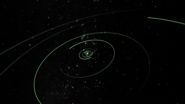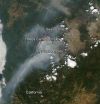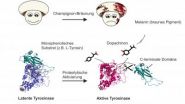(Press-News.org) This news release is available in German.
It could be difficult for the NSA to hack encrypted messages in the future – at least if a technology being investigated by scientists at the Max Planck Institute for the Science of Light in Erlangen and the University Erlangen-Nürnberg will be successful: quantum cryptography. The physicists are now laying the foundation to make this technique, which can already be used for the generation of secret keys, available for a wider range of applications. They are the first scientists to send a pulse of bright light in a particularly sensitive quantum state through 1.6 kilometres of air from the Max Planck Institute to a University building. This quantum state, which they call squeezed, was maintained, which is something many physicists thought to be impossible. Using flashes of bright light for quantum communication through the atmosphere would have several advantages compared to the technique usually used today: it allows the photon packets to be transmitted in sunlight, something that is challenging with individual photons. Moreover, the receivers required for this are already presently in use for optical telecommunication via fibre optics and also via satellite.
Eavesdropping on a message protected by quantum cryptography cannot be done without being noticed. This is because quantum physics prevents a spy from reading a key which is encoded by specific quantum states without influencing these states. This can be exploited in a clever procedure for exchanging the key with which the data is encrypted, so that an unwelcome listener is not only detected, but is also prevented from accessing the information.
The quantum-protected communication is a fragile thing, however, and easily disturbed. All the more remarkable is the work of the Erlangen-based scientists working with Gerd Leuchs, Director at the Max Planck Institute for the Science of Light and professor at the University Erlangen-Nürnberg: "We have now succeeded in transmitting a flash of light, namely a pulse which contains many photons, through the atmosphere in a particularly sensitive quantum state," says Christian Peuntinger, who played an important role in the project. He and his colleagues sent a photon packet in a straight line from the roof of the Max Planck Institute in Nuremberg to the building of the University Erlangen-Nürnberg some 1.6 kilometres away. "This even works in broad daylight," says Christian Peuntinger.
The Sun disturbs quantum communication with individual photons
Quantum communication and quantum cryptography have hitherto relied mainly on individual photons being the information carriers. Physicists have already carried out many experiments in which they have sent them through the air as well. The individual photons are only easy to detect in the dark, however, because they are masked by stray light, which abounds on a sunny day – just as an individual voice can hardly be heard in a noisy pub, especially if the conversation is to take place from one end of the room to the other. But just how useful is data traffic which has to stop when the Sun is shining?
If intense flashes of light transport the information, on the other hand, the communication is also possible in bright sunlight, as the special receivers used for this are not sensitive to stray light, unlike detectors for individual photons. This is not the only advantage that the receivers for the bright pulses offer, however. They are also much faster than the detectors for individual photons and thus allow higher transmission rates. And what makes them very attractive for the researchers in Erlangen: the devices needed are already widespread in optical communication via fibre-optic cable and even orbit Earth on board telecommunication satellites.
Until now, individual photons did seem to have one advantage over flashes of bright light, however. Individual photons can also be lost as they travel through the atmosphere; but if they reach their destination, they arrive in one piece and are unchanged. The attenuation in the atmosphere reduces only the data rate.
Communication with particularly sensitive, squeezed states
Quantum communication which uses flashes of many photons is thus not without its own difficulties: the flashes are suitable for quantum communication only if they exist in sensitive states. These are easily destroyed if a flash of light passes air turbulence and is deformed or weakened. "This is the reason why quantum physicists have not yet even tried to send such signals through the atmosphere," says Christoph Marquardt, Leader of the Quantum Information Processing Group at the Erlangen-based Max Planck Institute. His team has now proved that these pulses are indeed ideal for quantum communication through the air: "We have even used pulses in squeezed quantum states which are particularly sensitive."
Understanding what squeezed states are requires a brief digression to the foundations of quantum physics: Heisenberg's uncertainty principle applies to quantum particles. This principle states that position and momentum, or in simple terms the velocity, of a quantum particle have no exact values, neither do many of its other properties. Rather, measurements of these values show a certain uncertainty, even if the measurement method is as accurate as possible. If this rule were to make itself felt in our everyday world, the traffic police would have a difficult task: they would not be able to determine the position and the speed of a speeding motorist that would stand up in court.
Physicists can nevertheless employ several tricks to narrow down one property of a specific pair of characteristics – position and momentum form one such pair. The other measured quantity is all the more blurred, however. This would hardly be helpful for the traffic police: they could either determine how fast a speeding motorist was racing through a speed trap, but could then not take a photo as proof, because they wouldn't know in which direction to point the camera. Or they would successfully take the photograph, but would be unable to prove that the road hog had committed an offence, because the speed could only be very vaguely determined.
Turbulences cannot harm the polarisation
Physicists have a name for a state where one property is made more precise to the detriment of another - they call it squeezed. When they investigate the uncertainty trade-off with light, they call it squeezed light. "One would probably not use squeezed light to communicate via satellite, but it would be useful in quantum cryptography," says Christoph Marquardt. Non-squeezed flashes, that are less detrimental to losses would be possible to use for satellites: "We have also transmitted such pulses through the atmosphere," says Bettina Heim, who also worked on the experiment.
The researchers in Erlangen succeeded in transmitting the squeezed light by using a trick which with hindsight, as many good ideas, is quite obvious. The physicists have simply circumvented the problem that most squeezed states of light are destroyed by the turbulences in the air. They have squeezed properties which cannot be harmed by turbulences: the polarisation in two different orientations. The polarisation corresponds to the plane of oscillation of a light wave. "Even if the turbulences make the wave fronts of a light flash appear terribly deformed, the polarisation is maintained," says Christoph Marquardt.
In contrast to what many physicists expected, the squeezed state of the light signal was maintained during the transmission, albeit that the degree of squeezing suffered somewhat as a result of losses: the polarisation in one of the directions was no longer as sharply defined as it was before its journey through the atmosphere, and the polarisation in the other direction was less blurred when it arrived at the receiver. Their experiment has put the Erlangen-based researchers in a good position in an international race: several teams around the globe are working on making quantum communication via satellite possible. After all, satellites already own receivers for the bright pulses which the team in Erlangen has now transmitted through the atmosphere. The researchers now hope their quantum flashes will also be the first to be received by satellites.
INFORMATION: END
Squeezed quantum communication
2014-09-09
ELSE PRESS RELEASES FROM THIS DATE:
First evidence for water ice clouds found outside solar system
2014-09-09
VIDEO:
A team of scientists led by Carnegie's Jacqueline Faherty has discovered the first evidence of water ice clouds on an object outside of our own Solar System. Water ice clouds...
Click here for more information.
Washington, D.C.—A team of scientists led by Carnegie's Jacqueline Faherty has discovered the first evidence of water ice clouds on an object outside of our own Solar System. Water ice clouds exist on our own gas giant planets--Jupiter, Saturn, Uranus, and Neptune--but ...
Fires continue in Northern California
2014-09-09
Storms have been the major cause of the huge fires that California has been battling in its northern regions.
A lightning strike from a storm on August 12, 2014 started the fires in the Happy Camp Complex. There are currently 99,200 acres affected and the fire complex is at 30% containment.
At around 4pm PDT on September 08, the smoke inversion lifted and fire behavior significantly increased on the south and southeast sides of the fire with spotting distances of up to a mile. Multiple spot fires occurred across the Scott River from Swanson Gulch and McGuffy Creek. ...
High-stakes testing, lack of voice driving teachers out
2014-09-09
EAST LANSING, Mich. --- Contrary to popular opinion, unruly students are not driving out teachers in droves from America's urban school districts. Instead, teachers are quitting due to frustration with standardized testing, declining pay and benefits and lack of voice in what they teach.
So finds a Michigan State University education scholar – and former high school teacher – in her latest research on teacher turnover, which costs the nation an estimated $2.2 billion a year.
Alyssa Hadley Dunn, assistant professor of teacher education, conducted in-depth interviews ...
RT and concurrent chemotherapy after surgery is effective treatment for high-risk endometrial cancer
2014-09-09
Fairfax, Va., September 9, 2014—Radiation therapy with concurrent paclitaxel chemotherapy following surgery is an effective treatment for patients with high-risk endometrial cancer, according to a study published in the September 1, 2014 edition of the International Journal of Radiation Oncology ● Biology ● Physics (Red Journal), the official scientific journal of the American Society for Radiation Oncology (ASTRO).
Endometrial cancer is the most common gynecologic malignancy. Patients with early-stage disease are typically treated with surgery alone; however, ...
PP&AR sets national agenda for long-term care
2014-09-09
The number of Americans needing long-term care — also called long-term services and supports (LTSS) — is projected to more than double to 27 million by 2050. Approximately 70 percent of people over the age of 65 will rely on some form of LTSS for an average of three years. The latest issue of Public Policy & Aging Report (PP&AR) lays down a policy prescription for a sustainable system of LTSS in the U.S., using the Federal Commission on Long-Term Care's 2013 final report as its foundation.
With support from The SCAN Foundation, the issue presents nine articles under ...
Why do mushrooms turn brown?
2014-09-09
This news release is available in German.
The research team of Annette Rompel from the Institute for Biophysical Chemistry, University of Vienna explore the mechanisms behind the "browning reaction" during the spoilage of mushrooms. The researchers were able to demonstrate that the enzyme responsible is already formed prior to fungal spoiling. The detailed study is published online in the well renowned journals, Phytochemistry and Acta Crystallographica.
Understanding the mechanism of enzyme tyrosinase pigmentation is currently of both medical as well as technological ...
Growth factors found in breast milk may protect against necrotizing enterocolitis
2014-09-09
Philadelphia, PA, September 9, 2014 – Necrotizing enterocolitis (NEC) is a devastating gastrointestinal illness affecting up to 10% of premature infants, with a 30% mortality rate, and formula feeding has been identified as a risk factor for NEC. A study published in The American Journal of Pathology found that growth factors present in human breast milk, but not in formula, may explain the protection against intestinal damage. Further, supplementing the diet of newborn NEC-affected rodents with these growth factors promotes epithelial cell survival.
"NEC is a highly ...
A weekly text message could encourage healthier food choices, new study shows
2014-09-09
Many people are unaware that the U.S. Food and Drug Administration's mandated nutrition labels are based on a 2,000-calorie-a-day diet, but a simple weekly text message reminder can greatly improve that awareness, according to a new study from the Johns Hopkins Bloomberg School of Public Health.
While not an outright recommendation, the 2,000-calorie benchmark is what the FDA considers a reasonable daily calorie intake for many adults. More importantly, nutrition labels on food products sold in the U.S. are based on it.
The key to translating nutrition labels and ...
The saplings go their own way
2014-09-09
This news release is available in German. Leipzig. In tropical rainforests, most young trees grow spatially independent from their parent trees. This means that it is not possible to predict where seedlings will take root, and less specialised species therefore have an advantage even in the species-rich rainforests of the tropics. This is the finding of a study, conducted by researchers at the Helmholtz Centre for Environmental Research (UFZ), the University of California and the Smithsonian Tropical Research Institute, the results of which were published recently in ...
Study sheds light on asthma and respiratory viruses
2014-09-09
People with asthma often have a hard time dealing with respiratory viruses such as the flu or the common cold, and researchers have struggled to explain why.
In a new study that compared people with and without asthma, the answer is becoming clearer. The researchers found no difference in the key immune response to viruses in the lungs and breathing passages. The work, at Washington University School of Medicine in St. Louis, suggests that a fundamental antiviral defense mechanism is intact in asthma. This means that another aspect of the immune system must explain the ...






